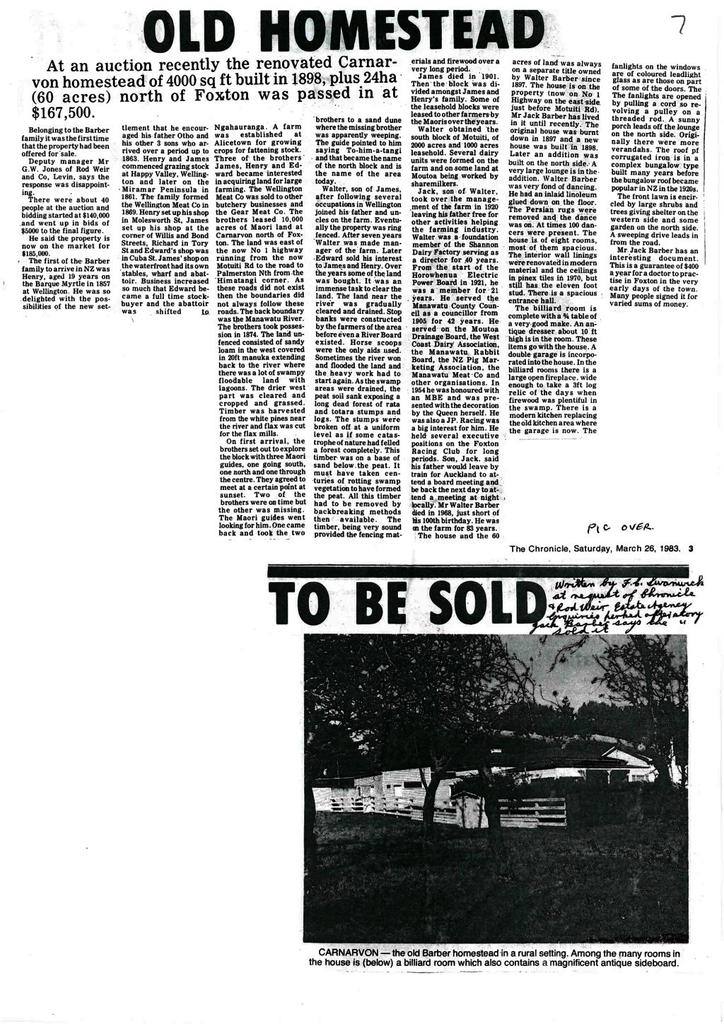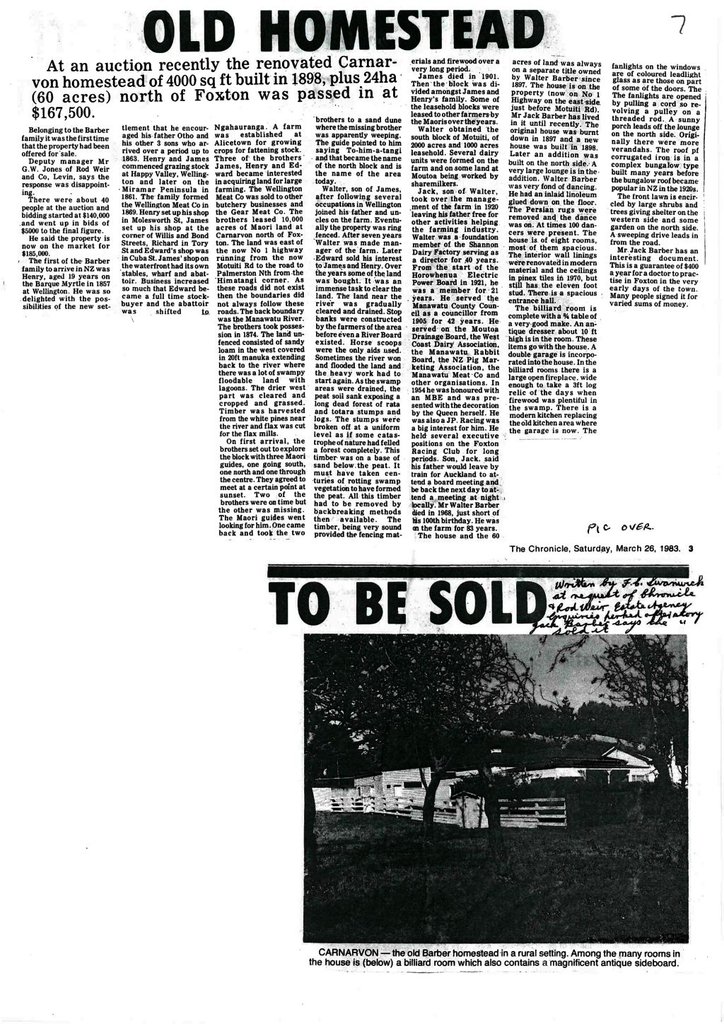Carnarvon Homestead
- Description
This text that follows is the content of the attached PDF.
Belonging to the Barber family, it was the first time that the property had been offered for sale.Deputy manager Mr G.W. Jones of Rod Weir and Co, Levin says the response was disappointing.
There were about 40 people at the auction and bidding started at $140,000 and went up in bids of $5000 to the final figure.
He said the property is now on the market for $185,000.
The first of the Barber family to arrive in NZ was Henry, aged 19 years on the Barque Myrtle in 1857 at Wellington. He was so delighted with the possibilities of the new settlement that he encouraged his father Otho and his other 3 sons who arrived over the period up to 1863. Henry and James commenced grazing stock at Happy Valley, Wellington and later on the Miramar Peninsula in 1861. The family formed the Wellington Meat Co in 1869. Henry set up his shop in Molesworth St, James set up his shop at the corner of Willis and Bond Streets. Richard in Tory St and Edward’s shop was in Cuba Street. James’ shop on the waterfront had its own stables, wharf and abattoir. Business increased so much that Edward became a full-time stock buyer and the abattoir was shifted to Ngauranga.
A farm was established at Alicetown for growing crops for fattening stock. Three of the brothers James, Henry and Edward became interested in acquiring land for large farming. The Wellington Meat Co was sold to other butchery businesses and the Gear Meat Co. The brothers leased 10,000 acres of Maori land at Carnarvon north of Foxton. The land was east of the now No 1 highway running from the now Motuiti Rd to the road to Palmerston Nth from the Himatangi corner. As these roads did not exist then the boundaries did not always follow these roads. The back boundary was the Manawatu River. The brothers took possession in 1874. The land unfenced consisted of sandy loam in the west covered in 20ft manuka extending back to the river where there was a lot of swampy floodable land with lagoons. The drier west part was cleared and cropped and grassed. Timber was harvested from the white pines near the river and flax mills.
On first arrival, the brothers set out to explore the block with three Maori guides, one going south, one north and one through the centre. They agreed to meet at a certain point at sunset. Two of the brothers were on time but the other was missing. The Maori guides went looking for him. One came back and took the two others to a sand dune where the missing brother was apparently weeping. The guide pointed to him saying -him-a-tangi- and that became the name of the north block and is the name of the area today.
Walter, son of James, after following several occupations in Wellington joined his father and uncles on the farm. Eventually the property was ring fenced. After seven years Walter was made manager of the farm. Later Edward sold his interest to James and Henry. Over the years some of the land was bought. It was an immense task to clear the land. The land near the river was gradually cleared and drained. Stop banks were constructed by the farmers of the area before even a River Board existed. Horse scoops were the only aids used.
Sometimes the river won and flooded the land and the heavy work had to start again. As the swamp areas were drained, the peat soil sank exposing a long dead forest of Rata and Totara stumps and logs. The stumps were broken off at a uniform level as if some catastrophe of nature had felled a forest completely. This timber was on a base of sand below the peat. It must have taken centuries of rotting swamp vegetation to have formed the peat. All this timber had to be removed by back breaking methods then available. The timber, being very sound provided the fencing materials and firewood over a very long period.
James died in 1901. Then the block was divided amongst James and Henry’s family. Some of the leasehold blocks were leased to other farmers by the Maori over the years.
Walter obtained the south block of Motuiti, of 2000 acres and 1000 acres leasehold. Several dairy units were formed on the farm and on some land at Moutoa being worked by share-milkers.
Jack, son of Walter, took over the management of the farm in 1920 leaving his father free for other activities helping the farming industry. Walter was a foundation member of the Shannon Dairy Factory serving as a director for 40 years. From the start of the Horowhenua Electric Power Board in 1921, he was a member for 21 years. He served the Manawatu County Council as councillor from 1905 for 42 years. He served on the Moutoa Drainage Board, the West Coast Dairy Association, and the Manawatu Rabbit Board, the NZ Pig Marketing Association, the Manawatu Meat Co and other organisations. In 1954 he was honoured with an MBE and was presented with the decoration by the Queen herself. He was also a JP. Racing was a big interest for him. He held several executive positions on the Foxton Racing Club for long periods. Son, Jack, said his father would leave by train for Auckland to attend a meeting at night locally. Mr Walter Barber died in 1968, just short of his 100th birthday. He was on the farm for 88 years.
The house and the 60 acres of land was always on a separate title owned by Walter Barber since 1897. The house is on the property (now on No1 Highway on the east side, just before Motuiti Rd). Mr Jack Barber has lived in it until recently. The original house was burnt down in 1897 and a new house was built in 1898. Later an addition was built on the north side. A very large lounge is in the addition. Walter Barber was very fond of dancing. He had inlaid linoleum glued down on the floor. The Persian rugs were removed and the dance was on. At times 100 dancers were present. The house is of eight rooms, most of them spacious. The interior wall linings were renovated in modern material and the ceilings in pinex tiles in 1970, but still has the eleven foot stud. There is a spacious entrance hall.
The billiard room is complete with a ¾ table of a very good make. An antique dresser about 10ft high is in the room. These items go with the house. A double garage is incorporated into the house. In the billiard rooms there is a large open fireplace wide enough to take a 3ft log, relic of the days when the firewood was plentiful in the swamp. There was a modern kitchen area where the garage is now. The fanlights on the windows are of coloured leadlight glass as are those on part of some of the doors. The fanlights are opened by pulling a cord so revolving a pulley on a threaded rod. A sunny porch leads off the lounge on the north side. Originally there were more verandas. The roof of corrugated iron is of a complex bungalow type built many years before the bungalow roof became popular in NZ in the 1920s.
The front lawn is encircled by large shrubs and trees giving shelter on the west side and some garden on the north side. Sweeping drive leads in from the road.
Mr Jack Barber has an interesting document. This is a guarantee of $400 a year for a doctor to practice in Foxton in the very early days of the town. Many people signed it for varied sums of money.
Identification
- Date
- March 26, 1983
Taxonomy
- Community Tags


